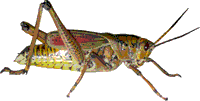Entomology Collections, General

Entomology Papers from Other Sources
Document Type
Article
Date of this Version
1986
Citation
W. H. Reissig, E.A. Heinrichs, J.A. Litsinger, K. Moody, L. Fiedler, T.W. Mew, A.T. Barrion. 1986. Illustrated Guide to Integrated Pest Management in Rice in Tropical Asia. IRRI, Philippines, 411 p.
Abstract
In the past, farmers in tropical Asia grew traditional rice cultivars and either relied primarily on cultural, mechanical, and physical methods of pest control or practiced no pest control. Pesticide application was limited because the yield potential of traditional varieties was too low to justify additional investments. Although pests destroyed part of each crop, severe outbreaks or epidemics were rare.
The widespread introduction of high-yielding rice cultivars in Asia in the last two decades and the associated changes in production practices have improved conditions for insects, diseases, weeds, and rodents. The higher yield potential of the new rices also made increased pesticide application economically attractive to farmers.
The replacement of traditional control methods by pesticides could increase hazards to nontarget organisms, however, and lead to the development of pesticide resistance and environmental contamination. To minimize such problems, Asian farmers must again diversify their pest control practices — a strategy that scientists now term integrated pest management (IPM).
Recently, scientists working in national rice production programs and at international agricultural research centers have written extensively about IPM for tropical rice. Many of the publications are research-oriented, fragmented, and too technical for nonscientists. Furthermore, much of the highly specialized information often focuses on a single species or a small group of pests.
This publication provides practical and comprehensive information to IPM workers in rice fields throughout tropical Asia. It briefly discusses rice plant structure and growth stages and stresses their relation to pest management. There are separate sections on cultural control of rice pests, resistant rice varieties, natural enemies of rice insect pests, and pesticides. The biology and management of the major groups of rice pests — insects, diseases, weeds, and rodents — are discussed in separate sections. Finally, integrated control measures for the entire rice pest complex and the implementation of IPM strategies at the farmer level are described.


Comments
Copyright © International Rice Research Institute 1986.